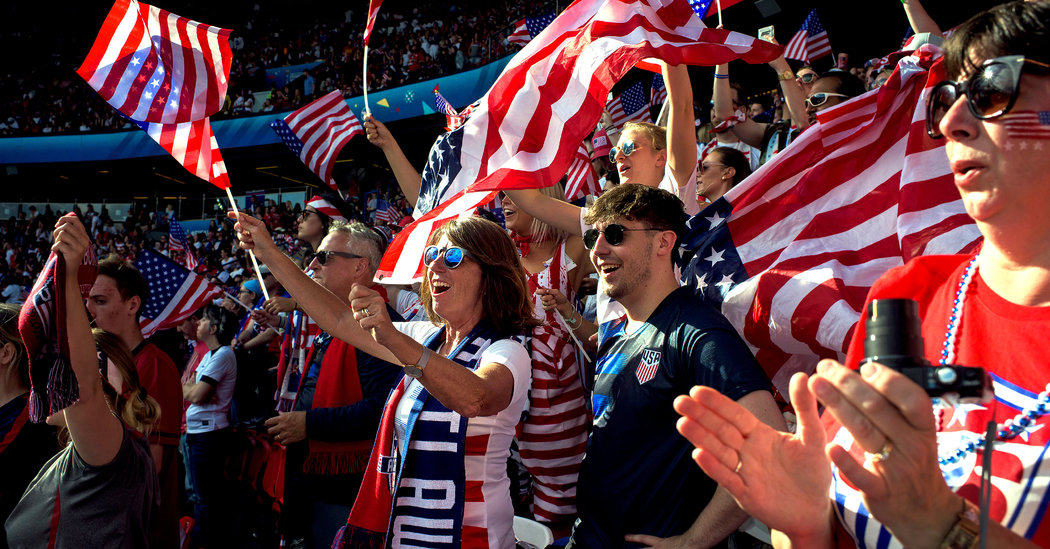LE HAVRE, France — When Spain took on South Africa in the Women’s World Cup this month, the stadium here in Le Havre was barely half full. The anemic turnouts continued when New Zealand played the Netherlands and when Spain faced China. The England-Argentina match drew a few more fans.
But the United States team is coming on Thursday, and “we are very, very excited about it,” one of the city’s deputy mayors, Sébastien Tasserie, said this week.
He envisions packed bars and restaurants, sold-out hotels, streets stuffed with fans and the stadium’s press box overflowing with reporters from around the world.
None of the 23 other teams wanted to draw the No. 1-ranked United States women at the World Cup. But each of the nine French host cities clamored for the Americans.
The calculation was simple: The United States team has a level of support unmatched in women’s sports, attracting thousands of fans wherever it plays.
“When you host the team, you know their fans will make their way,” said Alexandre Bariteaud, the tourism marketing director in Reims, where the Americans played Thailand last week. “So of course it was good news for us to hear we would have the U.S.A. team.”
His city’s hotel rooms sold out after the tournament schedule was released in December. Nearby towns benefited from the overflow.
The afternoon before the game, United States jerseys and other American-themed clothing seemed to be the unofficial uniform in the heart of the city. Waves of television crews filmed in front of the towering Reims Cathedral, where a throng jumped up and down and chanted “U-S-A! U-S-A!” for the cameras.
For officials in places like Le Havre, which will host Thursday’s game between the United States and Sweden, such a horde of supporters, even over a few days, can provide a powerful, short-term economic boost for businesses and, potentially, a long-term increase in international name recognition.
No visiting team but the United States can guarantee the same benefits.
This was why Mr. Bariteaud, and many others in Reims, were thrilled to learn last year that the Americans would play their first game — and possibly another in the knockout rounds — in their city.
Reims is the heart of the country’s Champagne-producing region, and Mr. Bariteaud said hosting the United States team was a valuable opportunity to display the city’s other charms before and after games.
When Americans arrived in Reims last week for their team’s opening match, chants filled the air around the cathedral in the afternoon and continued in the packed stadium that night.
“I can’t personally thank all of them, but the fans who have traveled, and what they create for us in terms of support for our players, is magnificent,” Coach Jill Ellis said about essentially having home-field advantage thousands of miles from home. “They’ve had to travel a long way and, I’m sure, at large expense.”
Fans at men’s tournaments are less likely to make a holiday of the occasion. They just show up, drink and go to a game, Mr. Bariteaud said, while acknowledging that he might be simplifying a bit. Women’s World Cup fans, he said, seemed to include far more families and groups of people interested in finding non-soccer, non-alcohol-related activities.
Natasha Balagot, her husband, Mark, and three children, ages 12, 10 and 8, fit that mold. They live in Mission Viejo, Calif., and have spent several thousand dollars on tickets and travel to France for a family vacation. Last-minute hotel cancellations in Le Havre, she said, allowed them to avoid staying an hour outside the city.
“We’re doing touristy stuff in France, but planning everything around the games,” Ms. Balagot said.
Attendance in the other World Cup’s host cities, as in Le Havre, has been inconsistent through the early stage, with a few games played in front of mostly empty stands.
At the men’s World Cup, with its long-entrenched following, cities can become overrun with fans regardless of which countries are playing. But for now, fans of women’s national teams simply do not travel in similar numbers.
The American fans are the exception. Before the opening match of the World Cup, FIFA announced that 130,905 tickets had been allocated to people from the United States, second only to those from France and more than those from all 22 other nations combined. Every match involving the Americans was sold out before the tournament began.
The level of media coverage is unmatched, as well: There are 108 journalists accredited from the United States, according to FIFA, including a couple of dozen dedicated to documenting the Americans’ every move.
The mayor’s office in Le Havre, which is trying to soften its old image as an industrial port, will do an economic analysis after the World Cup, but Mr. Tasserie said he had heard anecdotally from business owners that sales had increased around the previous games. That was why the prospect of American fans in town was so exciting.
“The United States comes with a very big delegation,” Mr. Tasserie said, “and it can be very important for the economy of our town.”
In the crowd was William Egoavil, 29, who had persuaded his girlfriend, Charity Mallon, 23, and three other friends to travel from Philadelphia. They planned to go to Le Havre on Thursday.
“It could have been anywhere in any country,” Mr. Egoavil said, “and I would have come.”
It was the sort of sentiment that host city officials love to hear.













